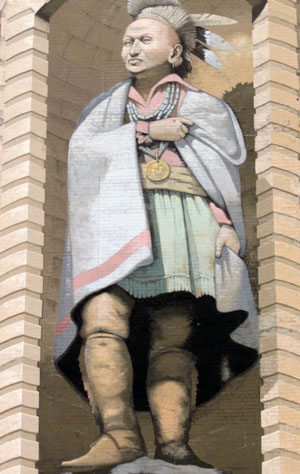
“Black Hawk” mural by Richard Haas - 1993
We must continue throughout our lives to do what we conceive to be good. - Sauk warrior Black Hawk (1767-1838)
Overlooking the Mississippi River from the back of an office building in downtown Rock Island looms a mural of Black Hawk, the Native American leader of the Sauk Nation.
It was on the 4th of July I noticed the painting while driving along Illinois’ Highway 92, thinking about the Declaration of Independence and its meaning. My eyes were drawn to the six-story painting that looks toward the Mississippi River, or the Great River as it was known among the Native Peoples of the Mississippi River Basin.
Thomas Jefferson’s words in that founding document proclaims: "human beings, being created equal, have the right to life, liberty and the pursuit of happiness, and that this right is inalienable. The right is inborn in every human being and cannot be bestowed as a privilege by any human power; nor should it be curtailed for to do so would be a crime against humanity and humanity’s Creator."
Black Hawk, born before America’s independence, witnessed this nation’s birth and expansive growth across the North American continent. He fought against her on the side of the British in the War of 1812 in the hope of staving off the mass migration of Europeans into Native American land.
When treaties to protect the Native American land from incursions by settlers were disregarded and broken, he fought them himself, with followers from the Sauk, Fox and Kickapoo tribes in the Black Hawk War.
The war involved massacres on all sides of the conflict. After being defeated, Black Hawk and his followers were resettled in south central Iowa, and Black Hawk died in Iowa’s Davis County.
Even in death Black Hawk would not find peace. A man named James Turner stole his skeleton with hopes of displaying it for profit. Black Hawk’s sons appealed to then Iowa’s Territorial Governor Robert Lucas, and his bones were then housed at the Burlington, Iowa Geological and Historical Society. In 1855, the building burned down and Black Hawk’s remains were lost.
In this scheme of things, Black Hawk stands as a witness to the incongruity of America’s ideals as avowed in the Declaration of Independence and the reality of her history. On the banks of the Great River, this Native American warrior and freedom fighter looms as a conscience to remind us of our higher calling.
Do the rights to life, liberty and the pursuit of happiness go hand-in-hand? Is life only meaningful when it is free, and is freedom only meaningful when it is in pursuit of happiness?
What then is happiness? It’s not simply about feeling good. Our “good” feelings come and go and often our bad feelings, such as grief and even depression, can offer our lives a depth that “feeling good” cannot provide.
Happiness is about well-being, about being as whole as possible, and being the persons we were created to be. The words of Black Hawk speaks to us: “We must continue throughout our lives to do what we conceive to be good."
Happiness –- our wellbeing –- is only a reality when we “throughout our lives … do what we conceive to be good.” In this way, happiness is pursued, freedom has dignity and life has meaning.
Another 4th of July has come and gone, and for most of us –-including myself -– we continue to pursue what we think will make us feel good rather than conceiving to do what is good. In this way, we belittle ourselves and dishonor the ideals that gave our nation its birth.



